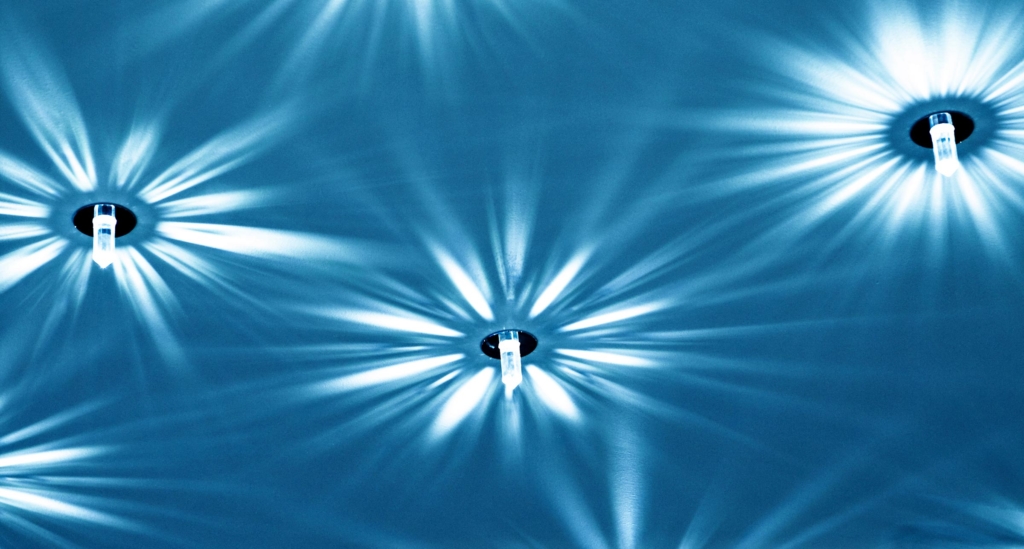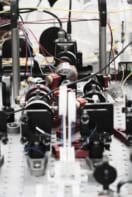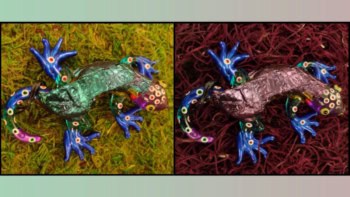The humble household light bulb – once a simple source of illumination – could soon be transformed into the backbone of a revolutionary new wireless communications network based on visible light. Harald Haas explains how this “LiFi” system works and how it could shape our increasingly data-driven world
Over the past year the world’s computers, mobile phones and other devices generated an estimated 12 zettabytes (1021 bytes) of information. By 2020 this data deluge is predicted to increase to 44 zettabytes – nearly as many bits as there are stars in the universe. There will also be a corresponding increase in the amount of data transmitted over communications networks, from 1 to 2.3 zettabytes. The total mobile traffic including smartphones will be 30 exabytes (1018 bytes). A vast amount of this increase will come from previously uncommunicative devices such as home appliances, cars, wearable electronics and street furniture as they become part of the so-called “Internet of Things”, transmitting some 335 petabytes (1015 bytes) of status information, maintenance data and video to their owners and users for services such as augmented reality.
In some fields, this data-intensive future is already here. A wind turbine, for example, creates 10 terabytes of data per day for operational and maintenance purposes and to ensure optimum performance. But by 2020 there could be as many as 80 billion data-generating devices all trying to communicate with us and with each other – often across large distances, and usually without a wired connection.
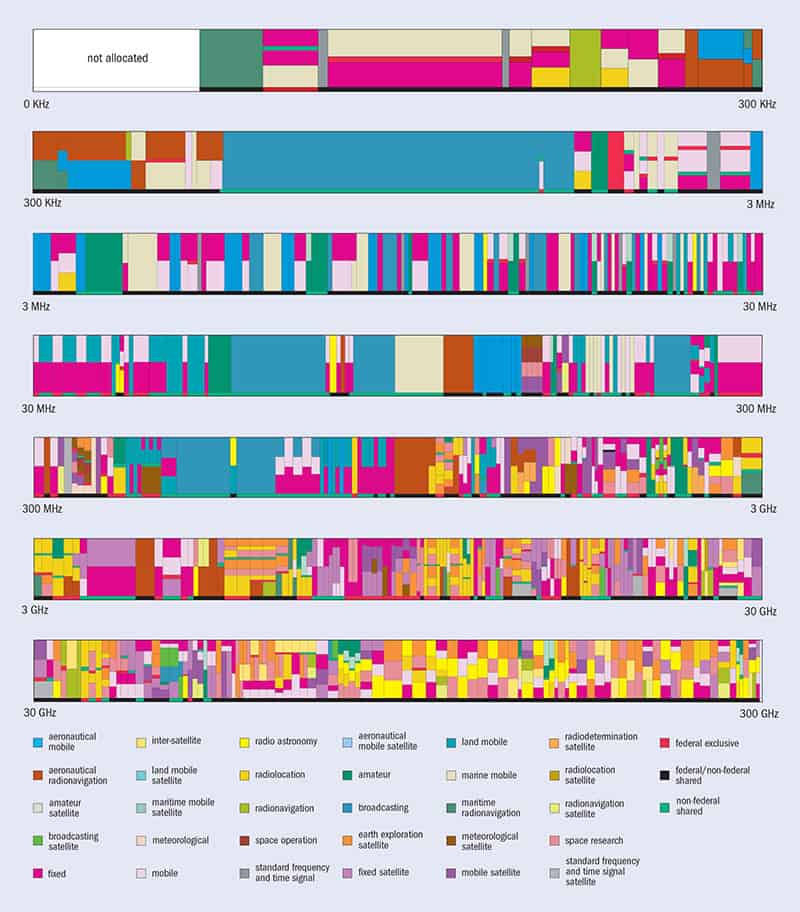
So far, the resources required to achieve this wireless connectivity have been taken almost entirely from the radio frequency (RF) part of the electromagnetic spectrum (up to 300 GHz). However, the anticipated exponential increase in data volumes during the next decade will make it increasingly hard to accomplish this with RF alone. The RF spectrum “map” of the US is already very crowded (figure 1), with large chunks of frequency space allocated to services such as satellite communication, military and defence, aeronautical communication, terrestrial wireless communication and broadcast. In many cases, the same frequency band is used for multiple services. So how are we going to accommodate perhaps 70 billion additional communication devices?
At this point it is helpful to remember that RF is only one small part of the electromagnetic spectrum. The visible-light portion of the spectrum stretches from about 430 to 770 THz, more than 1000 times the bandwidth of the RF portion. These frequencies are seldom used for communication, even though visible-light-based data transmission has been successfully demonstrated for decades in the fibre-optics industry. The difference, of course, is that the coherent laser light used in fibre optics is confined to cables rather than being transmitted in free space. But might it be possible to exploit the communication potential of the visible-light region of the spectrum while also benefitting from the convenience and reach of wireless RF?
With the advent of high-brightness light-emitting diodes (LEDs), I believe the logical answer is “yes”. Using this new “LiFi” system (a term I coined in a TED talk in 2011), it will be possible to achieve high-speed, secure, bi-directional and fully networked wireless communications with data encoded in visible light. In a LiFi network, every light source – a light bulb, a street lamp, the head and/or tail light of a car, a reading light in a train or an aircraft – can become a wireless access point or wireless router like our WiFi routers at home. However, instead of using RF signals, a LiFi network modulates the intensity of visible light to send and receive data at high speeds – 10 gigabits per second (Gbps) per light source are technically feasible. Thus, our lighting networks can be transformed into high-speed wireless communications networks where illumination is only a small part of what they do.
The ubiquitous nature of light sources means that LiFi would guarantee seamless and mobile wireless services (figure 2). A single LiFi access point will be able to communicate to multiple terminals in a bi-directional fashion, providing access for multiple users. If the terminals move (for example, if someone walks around while using their phone) the wireless connection will not be interrupted, as the next-best-placed light source will take over – a phenomenon referred to as “handover”. And because there are so many light sources, each of them acting as an independent wireless access point, the effective data rate that a mobile user will experience could be orders of magnitude higher than is achievable with current wireless networks. Specifically, the average data rate that is delivered to a user terminal by current WiFi networks is about 10 megabits per second; with a future LiFi network this can be increased to 1 Gbps.
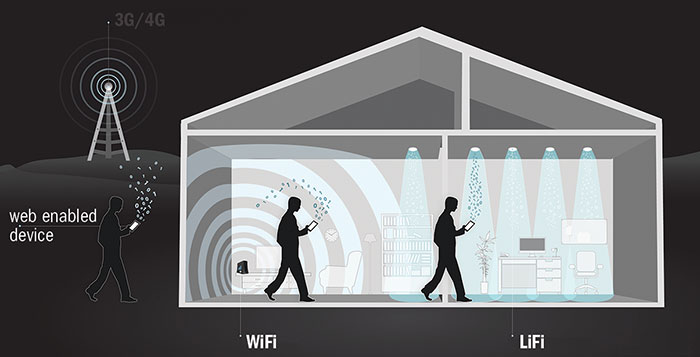
This radically new type of wireless network also offers other advantages. One is security. The next time you walk around in an urban environment, note how many WiFi networks appear in a network search on your smartphone. In contrast, because light does not propagate through opaque objects such as plastered walls, LiFi can be much more tightly controlled, significantly enhancing the security of wireless networks. LiFi networks are also more energy efficient, thanks to the relatively short distance between a light source and the user terminal (in the region of metres) and the relatively small coverage area of a single light source (10 m2 or less). Moreover, because LiFi piggybacks on existing lighting systems, the energy efficiency of this new type of wireless network can be improved by three orders of magnitude compared with WiFi networks. A final advantage is that because LiFi systems don’t use an antenna to receive signals, they can be used in environments that need to be intrinsically safe such as petrochemical plants and oil-drilling platforms, where a spark to or from an antenna can cause an explosion.
LiFi misconceptions
A number of misconceptions commonly arise when I talk to people about LiFi. Perhaps the biggest of these is that LiFi must be a “line-of-sight” technology. In other words, people assume that the receiver needs to be directly in line with the light source for the data connection to work. In fact, this is not the case. My colleagues and I have shown that for a particular light-modulation technology, the data rate scales with the signal-to-noise ratio (SNR), and that it is possible to transmit data at SNRs as low as –6 dB. This means LiFi can tolerate signal blockages between 46 and 66 dB (signal attenuation factors of 40,000 – 4 million). This is important because in a typical office environment where the lights are on the ceiling and the minimum level of illumination for reading purposes is 500 lux, the SNR at table height is between 40 and 60 dB, as shown by Jelena Grubor and colleagues at the Fraunhofer Institute for Telecommunications in Berlin, Germany (2008 Proceedings of the 6th International Symposium Communication Systems, Networks and Digital Signal Processing 165). In our own tests we transmitted video to a laptop over a distance of about 3 m. The LED light fixture was pointing against a white wall, in the opposite direction to the location of the receiver, therefore there was no direct line-of-sight component reaching the receiver, yet the video was successfully received via reflected light.
Another misconception is that LiFi does not work when it is sunny. If true, this would be a serious limitation, but in fact, the interference from sunlight falls outside the bandwidth used for data modulation. The LiFi signal is modulated at frequencies typically greater than 1 MHz, so sunlight (even flickering sunlight) can simply be filtered out, and has negligible impact on the performance as long as the receiver is not saturated (saturation can be avoided by using algorithms that automatically control the gain at the receiver). Indeed, my colleagues and I argue that sunlight is hugely beneficial for LiFi, as it is possible to create solar-cell-based LiFi receivers where the solar cell acts as a data receiver device at the same time as it converts sunlight into electricity.
A third misconception relates to the behaviour of the light sources. Some have suggested that the light sources used in LiFi cannot be dimmed, but in fact, sophisticated modulation techniques make it possible for LiFi to operate very close to the “turn on voltage” of the LEDs. This means that the lights can be operated at very low light output levels while maintaining high data rates. Another, related concern is that the modulation of LiFi lights might be visible as “flicker”. In reality, the lowest frequency at which the lights are modulated, 1 MHz, is 10,000 times higher than the refresh rate of computer screens (100 Hz). This means the “flicker-rate” of a LiFi light bulb is far too quick for human or animal eyes to perceive.
A final misconception is that LiFi is a one-way street, good for transmitting data but not for receiving it. Again, this is not true. The fact that LiFi can be combined with LED illumination does not mean that both functions always have to be used together. The two functions – illumination and data – can easily be separated (note my previous comment on dimming), so LiFi can also be used very effectively in situations where lighting is not required. In these circumstances, the infrared output of an LED light on the data-generating device would be very suitable for the “uplink” (i.e. for sending data). Because infrared sensors are already incorporated into many LED lights (as motion sensors, for example), no new technology would be necessary, and sending a signal with infrared requires very little power: my colleagues and I have conducted an experiment where we sent data at a speed of 1.1 Gbps over a distance of 10 m using an LED with an optical output power of just 4.5 mW. Using infrared for the uplink has the added advantage of spectrally separating uplink and downlink transmissions, avoiding interference.
Nuts and bolts
Now that we know what LiFi can and cannot do, let’s examine how it works. At the most basic level, you can think of LiFi as a network of point-to-point wireless communication links between LED light sources and receivers equipped with some form of light-detection device, such as a photodiode. The data rate achievable with such a network depends on both the light source and the technology used to encode digital information into the light itself.
First, let’s consider the available light sources. Most commercial LEDs have a blue high-brightness LED with a phosphorous coating that converts blue light into yellow; the blue light and yellow light then combine to produce white light. This is the most cost-efficient way to produce white light today, but the colour-converting material slows down the light’s response to intensity modulation, meaning that higher frequencies (blue light) are heavily attenuated. Consequently, the light intensity from this type of LED can only be modulated at a fairly low rate, about 2 MHz. It is also not possible to modulate the individual spectral components (red, green and blue) of the resulting white light; all you can do is vary the intensity of the composite light spectrum. Even so, one can achieve data rates of about 100 Mbps with these devices by placing a blue filter placed at the receiver to remove the slow yellow spectral components.
More advanced red, green and blue (RGB) LEDs produce white light by mixing these base colours instead of using a colour-converting chemical. This eases the restrictions on modulation rates, making it possible to achieve data rates of up to 5 Gbps. In addition, one can encode different data onto each wavelength (a technique known as wavelength division multiplexing), meaning that for an RGB LED there are effectively three independent data channels available. However, because they require three separate light sources, these devices are more expensive than single blue LEDs.
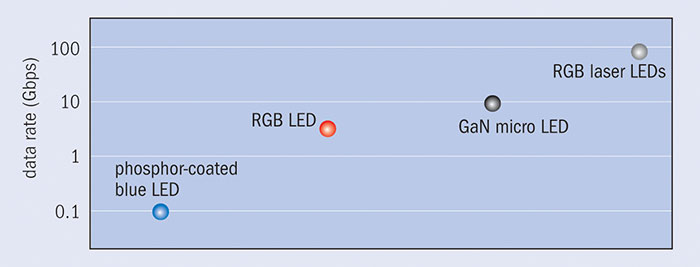
A third alternative – gallium-nitride micro LEDs – are small devices that achieve very high current densities, with a bandwidth of up to 1 GHz. Data rates of up to 10 Gbps have recently been demonstrated with these devices by Hyunchae Chun and colleagues (2016 Journal of Lightwave Technology, in press). This type of LED currently is a relatively poor source of illumination compared with phosphor-coated white LEDs or RGB LEDs, but it would be ideal for uplink communications – for example, in an Internet of Things where an indicator light on an oven is capable of sending data to a light bulb in the ceiling – and in the future we may also see these devices in a light bulb due to rapid technology enhancements.
Lastly, white light can also be generated with multiple colour laser diodes combined with a diffuser. This technology may be used in the future for lighting due to the very high efficiency of lasers, but currently its cost is excessive and technical issues such as speckle have to be overcome. However, my University of Edinburgh colleagues Dobroslav Tsonev, Stefan Videv and I have recently demonstrated a white light beam of 1000 lux covering 1 m2 at a distance of 3 m, and the achievable data rate for this scenario is 100 Gbps (2015 Opt. Express 23 1627).
As for the modulation, my group at Edinburgh has been pioneering a digital modulation technique called orthogonal frequency division multiplexing (OFDM) for the past 10 years. The principle of OFDM is to divide the entire modulation spectrum (that is, the range of frequencies used to change the light intensity into modulated data) into many smaller frequency bins. Some of these frequencies are less attenuated than others (due to the nature of the propagation channel and LED and photodetector device characteristics), and information theory tells us that the less-attenuated frequency bins are able to carry more information bits than those that are more attenuated. Hence, the dividing of the spectrum into many smaller bins allows us to “load” each individual bin with the optimum number of information bits. This makes it possible to achieve higher data rates than one gets with more traditional modulation techniques, such as on– off keying.
These high data rates make it easier to adapt to varying propagation channels, where the frequency bin attenuation changes with location – something that is important for a wireless communications system. The whole process can be compared to an audio sound equalizer system that individually adjusts low frequencies (bass), middle frequencies and high frequencies (treble) to suit a particular optimum sound profile, independent of where the listener is in the room. My former students Mostafa Afgani and Hany Elgala, together with me and my colleague Dietmar Knipp, have demonstrated what is, to the best of our knowledge, the first OFDM implementation for visible light communication (2006 IEEE Tridentcom 129).
The bright future
LiFi is a disruptive technology that is poised to affect a large number of industries. Most importantly, I expect it to catalyse the merger of wireless communications and lighting, which are at the moment entirely separate businesses. Within the lighting industry, the concept of light as a service, rather than a physical object you buy and replace, will become a dominant theme, requiring industry to develop new business models to succeed in a world where individual LED lamps can last more than 20 years. In combination with LiFi, therefore, light-as-a-service will pull the lighting industry to enter what has traditionally been a wireless communications market.
In terms of how it affects daily life, I believe LiFi will contribute to the fifth generation of mobile telephony systems (5G) and beyond. As the Internet of Things grows, LiFi will unlock its potential, making it possible to create “smart” cities and homes. In the transport sector, it will enable new intelligent transport systems and enhance road safety as more and more driverless cars begin operating. It will create new cyber-secure wireless networks and enable new ways of health monitoring in ageing societies. Perhaps most importantly, it will offer new ways of closing the “digital divide”; despite considerable advances, there are still about four billion people in the world who cannot access the Internet. The bottom line, though, is that we need to stop thinking of light bulbs as little heaters that also provide light. In 25 years, my colleagues and I believe that the LED light bulb will serve thousands of purposes, not just illumination.
